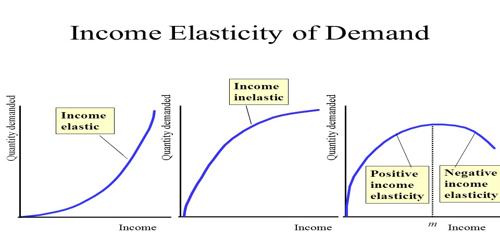Concept of Income Elasticity of Demand
The income elasticity of demand shows the responsiveness of quantity demanded of a certain commodity to the change in income of the consumer. The income elasticity of demand is also defined as ‘ the ratio of the percentage change in the demand for a commodity to the percentage change in income’. Income elasticity of demand can be expressed as follows:
Income elasticity = Percentage change in quantity demanded / Percentage change in income
For example, consumer’s income rises from $ 100 to $ 102, his demand for good X increases from 25 units per week to 30 units per week then his income elasticity of demand X is:
Income elasticity = 5/25 x 100/2 = 10
It means that 1 percent increase in income results 10 percent increase in demand and vice versa.

Explanation:
Income elasticity of demand is used to see how sensitive the demand for a good is to an income change. The higher the income elasticity, the more sensitive demand for a good is to income changes. A very high income elasticity suggests that when a consumer’s income goes up, consumers will buy a great deal more of that good and, conversely, that when income goes down consumers will cut back their purchases of that good to an even greater degree. A very low price elasticity implies just the opposite, that changes in a consumer’s income have little influence on demand.
The income elasticity may be positive or negative or zero depending upon the nature of a commodity. As a rise in income leads to an increase in demand, the income elasticity is positive. A commodity which has positive income elasticity is a normal good. On the other hand, when a rise in income leads to a decrease in demand for a commodity, its income elasticity is negative. Such a commodity is called inferior good. If the quantity of a commodity purchased remains unchanged, even at the change in income, the income elasticity of demand is zero.
The income elasticity of demand is usually strongly positive for:
- Fine wines and spirits, high quality chocolates (e.g. Lindt) and luxury holidays overseas
- Consumer durables – audio visual equipment, 3G mobile phones and designer kitchens
- Sports and leisure facilities (including gym membership and sports clubs)
In contrast, income elasticity of demand is lower for.
- Staple food products such as bread, vegetables and frozen foods
- Mass transport (bus and rail)
- Beer and takeaway pizza!
- Income elasticity of demand is negative (inferior) for cigarettes and urban bus services.
How do businesses make use of estimates of income elasticity of demand?
Knowledge of income elasticity of demand helps firms predict the effect of an economic cycle on sales. Luxury products with high income elasticity see greater sales volatility over the business cycle than necessities where demand from consumers is less sensitive to changes in the cycle.
Inferior goods have a negative income elasticity of demand meaning that demand falls as income rises. Typically inferior goods or services exist where superior goods are available if the consumer has the money to be able to buy it. Examples include the demand for cigarettes, low-priced own label foods in supermarkets and the demand for council-owned properties.
Information Source:
















